Search Result
Results for "
Arg-Arg-Arg-Arg
" in MedChemExpress (MCE) Product Catalog:
| Cat. No. |
Product Name |
Target |
Research Areas |
Chemical Structure |
-
- HY-P0121
-
ReACp53
2 Publications Verification
|
MDM-2/p53
|
Cancer
|
|
ReACp53 could inhibit p53 amyloid formation and rescue p53 function in cancer cell lines.
|
-

-
- HY-P3349
-
|
|
Bacterial
|
Infection
|
|
c[Arg-Arg-Arg-Arg-Nal-Nal-Nal] (Compound 9C) shows broad-spectrum activity against drug-resistant Gram-positive and Gram-negative bacteria, with MICs of 3.1, 3,1, 12.5, and 25 μg/mL for MRSA (ATCC BAA-1556), S. aureus (ATCC 29213), P. aeruginosa (ATCC 27883), and E. coli (ATCC 25922), respectively .
|
-
![c[<em>Arg-Arg-Arg-Arg</em>-Nal-Nal-Nal]](//file.medchemexpress.com/product_pic/hy-p3349.gif)
-
- HY-P3348
-
|
|
Bacterial
|
Infection
|
|
c[Arg-Arg-Arg-Arg-Dip-Dip-Dip] (Compound 8C) shows broad-spectrum activity against drug-resistant Gram-positive and Gram-negative bacteria, with MICs of 3.1, 3,1, 12.5, and 12.5 μg/mL for MRSA (ATCC BAA-1556), S. aureus (ATCC 29213), P. aeruginosa (ATCC 27883), and E. coli (ATCC 25922), respectively .
|
-
![c[<em>Arg-Arg-Arg-Arg</em>-Dip-Dip-Dip]](//file.medchemexpress.com/product_pic/hy-p3348.gif)
-
- HY-P10167
-
|
|
Phosphatase
|
Others
|
|
11R-CaN-AID is a potent and cell permeant inhibitor of calcineurin .
|
-

-
- HY-P3245
-
|
|
Apoptosis
|
Cancer
|
|
HXR9 is a cell-permeable peptide and a competitive antagonist of HOX/PBX interaction. HXR9 antagonizes the interaction between HOX and a second transcrip-tion factor (PBX), which binds to HOX proteins in paralogue groups1 to 8. HXR9 selectively decreases cell proliferation and promotes apoptosis in cells with a high level of expression of the HOXA/PBX3 genes, such as MLL-rearranged leukemic cells .
|
-

-
- HY-P10387
-
|
|
METTL3
Apoptosis
|
Cancer
|
|
RSM3, a stapled peptide, is a METTL3-METTL14 inhibitor with an Kd of 3.10 μM. RSM3 inhibits tumor growth while induces cell apoptosis. RSM3 can be used for study of cancer .
|
-

-
- HY-P2247
-
|
|
JNK
|
Cancer
|
|
JTP10-△-R9 TFA is a selective JNK2 peptide inhibitor, with an IC50 of 89 nM, exhibiting 10-fold selectivity for JNK2 over JNK1 and JNK3 .
|
-

-
- HY-P2282
-
|
|
STAT
|
Cancer
|
|
APTSTAT3-9R, a specific STAT3-binding peptide, inhibits STAT3 activation and downstream signaling by specifically blocking STAT3 phosphorylation. APTSTAT3-9R exerts antiproliferative effects and antitumor activity .
|
-
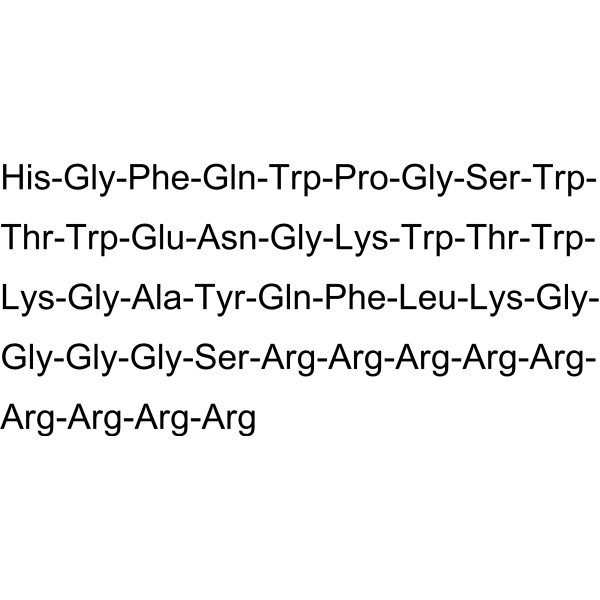
-
- HY-P4086
-
|
|
RABV
|
Infection
|
|
Chimeric Rabies Virus Glycoprotein Fragment (RVG-9R), a chimeric peptide consisting of 29 amino acids, is synthesized by adding nona-arginine motif to the carboxy terminus of RVG (rabies virus glycoprotein). Chimeric Rabies Virus Glycoprotein Fragment (RVG-9R) is positively charged and able to bind negatively charged nucleic acids via charge interaction .
|
-

-
- HY-P10150
-
|
|
Bacterial
|
Infection
|
|
IN-2-LF is an inhibitor of lethal factor. IN-2-LF also inhibits furin with an IC50 of 2 μM. IN-2-LF enhances protection against anthrax lethal toxin when in combination with D6R .
|
-
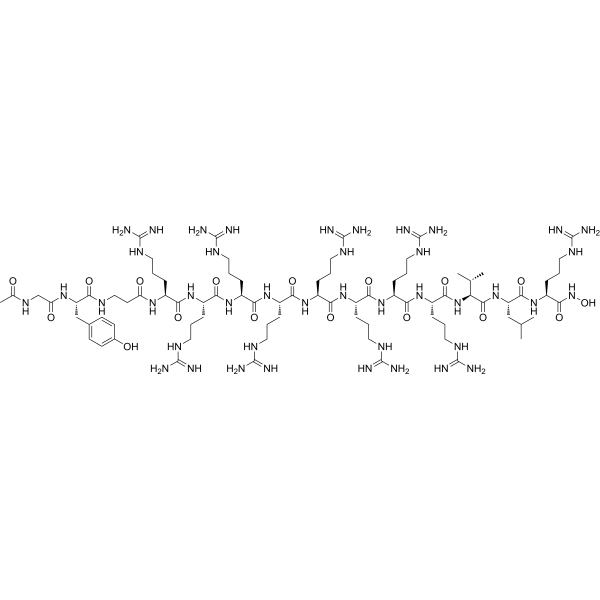
-
- HY-P1925A
-
|
|
PI3K
Reactive Oxygen Species
Apoptosis
|
Cancer
|
|
GO-203 TFA is a potent MUC1-C oncoprotein inhibitor. GO-203 TFA is an all D-amino acid peptide that consists of a poly-R transduction domain linked to a CQCRRKN motif that binds to the MUC1-C cytoplasmic tail and blocks MUC1-C homodimerization. GO-203 TFA downregulates TIGAR (TP53-induced glycolysis and apoptosis regulator) protein synthesis by inhibiting the PI3K-AKT-S6K1 pathway. GO-203 TFA induces the production of ROS and loss of mitochondrial transmembrane potential. GO-203 TFA inhibits the growth of colon cancer cells in vitro and as xenografts in nude mice .
|
-

-
- HY-126810A
-
|
|
Fungal
|
Infection
|
|
NP213 TFA is a rapidly acting, novel, first-in-class synthetic antimicrobial peptide (AMP), has anti-fungal activities. NP213 TFA targets the fungal cytoplasmic membrane and plays it role via membrane perturbation and disruption. NP213 TFA is effective and well-tolerated in resolving nail fungal infections .
|
-
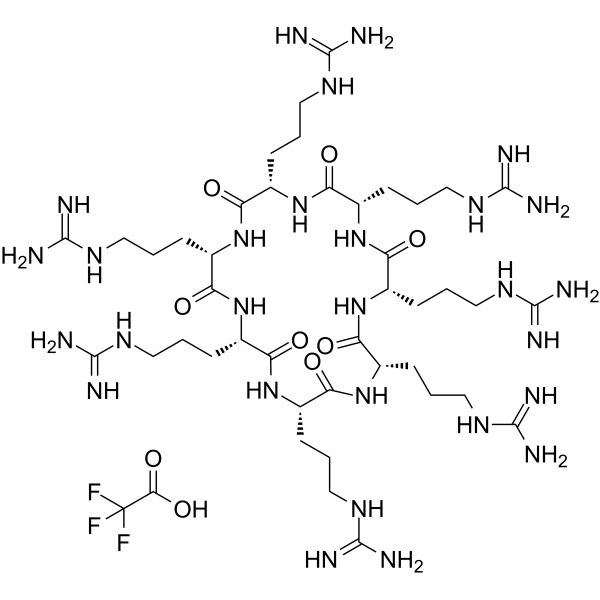
-
- HY-P5107
-
|
|
VEGFR
|
Cancer
|
|
Protein LMWP is a cell-penetrating peptide with vascular endothelial growth factor (VEGF) inhibitory activity. Protein LMWP can inhibit tumor growth and is used in cancer research .
|
-
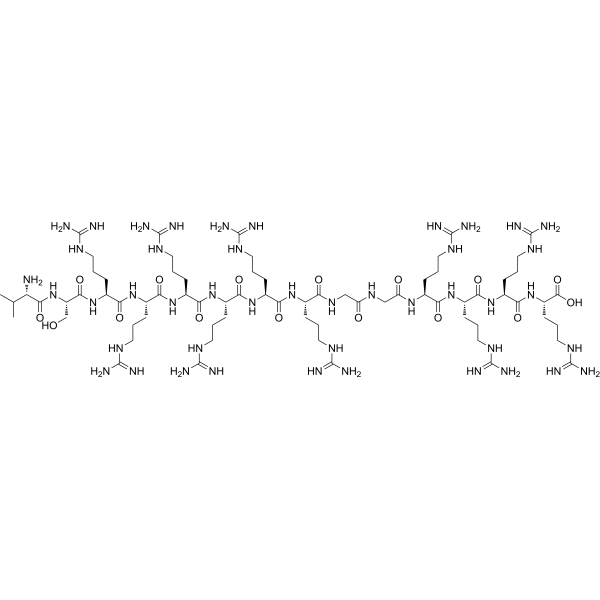
-
- HY-P5552
-
|
|
Bacterial
Parasite
Fungal
|
Infection
|
|
Melimine is a hybrid antimicrobial peptide of Melittin (HY-P0233) and Protamine. Melimine is active against P. aeruginosa and S. aureus. Melimine has broad spectrum activity against bacteria, fungi and protozoa .
|
-

-
- HY-P1028A
-
|
Furin Inhibitor II TFA
|
Bacterial
|
Infection
|
|
Hexa-D-arginine TFA (Furin Inhibitor II TFA) is a stable furin inhibitor with Ki values 106 nM, 580 nM and 13.2 μM for furin, PACE4 and prohormone convertase-1 (PC1), respectively. Hexa-D-arginine TFA blocks Pseudomonas exotoxin A and anthrax toxins toxicity in vitro and in vivo .
|
-
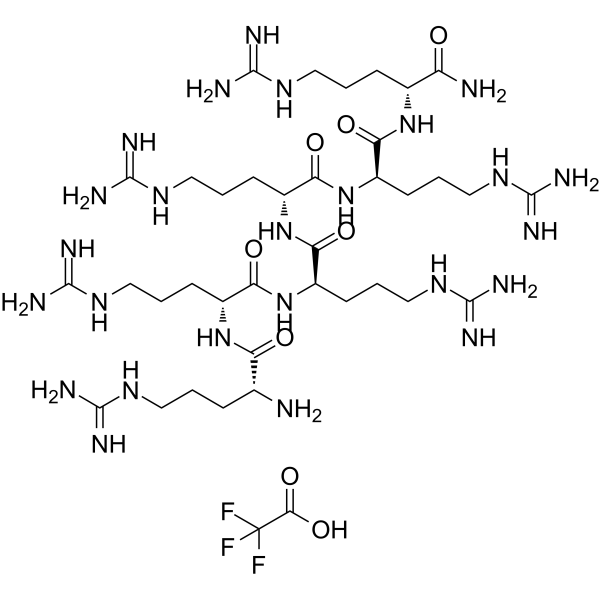
-
- HY-P5557
-
|
|
Bacterial
Necroptosis
|
Cancer
|
|
TP4 (Nile tilapia piscidin) is an orally active piscidin-like antimicrobial peptide. TP4 inhibits multiple gram positive and negative strains (MIC: 0.03-10 μg/mL). TP4 shows hemolytic activities. TP4 enhances immune response, antioxidant activity, and intestinal health against bacterial infections. TP4 also has anti-tumor effect, and induces necrosis by triggering mitochondrial dysfunction in cancer cells .
|
-

-
- HY-P1175
-
|
|
TRP Channel
|
Neurological Disease
|
|
L-R4W2 is a potent antagonist of vanilloid receptor 1 (VR1, TRPV1), with an IC50 of 0.1 μM. L-R4W2 may act as a potent analgesic .
|
-
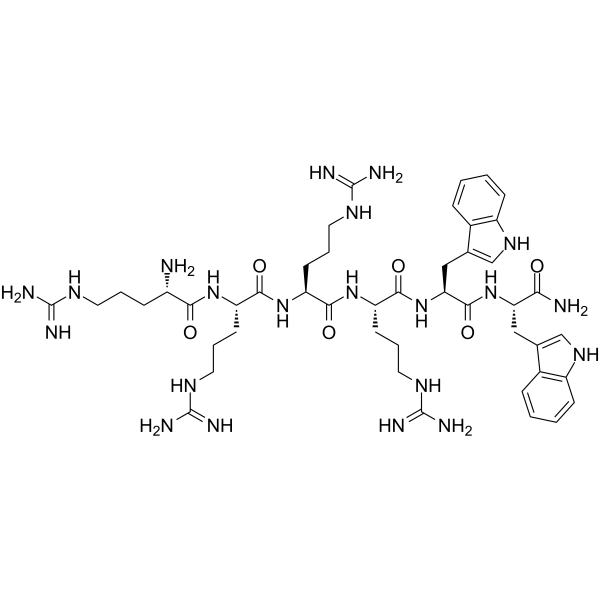
-
- HY-P1175A
-
|
|
TRP Channel
|
Neurological Disease
|
|
L-R4W2 TFA is a potent antagonist of vanilloid receptor 1 (VR1, TRPV1), with an IC50 of 0.1 μM. L-R4W2 TFA may act as a potent analgesic .
|
-
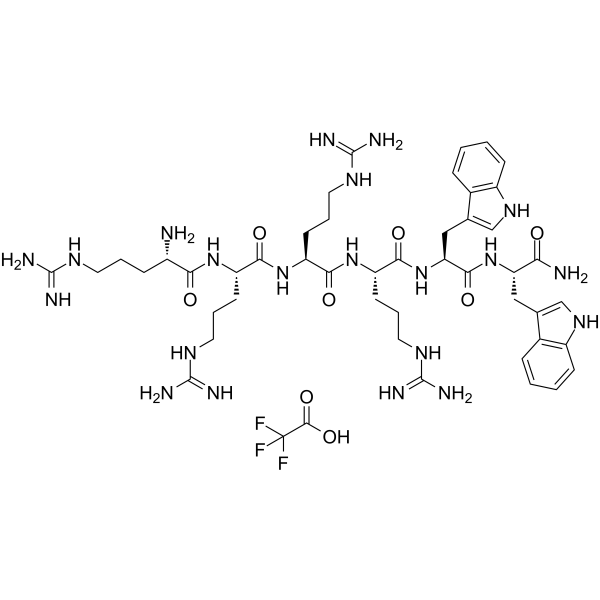
-
- HY-P1586
-
|
HIV-1 rev Protein (34-50)
|
HIV
|
Infection
|
|
HIV-1 Rev (34-50) is a 17-aa peptide derived from the Rev-responsive element (RRE)-binding domains of Rev in HIV-1, with anti-HIV-1 activity.
|
-

-
- HY-P10445
-
|
|
Liposome
|
Cancer
|
|
TAT-PiET is a liposome to simulate biological phospholipid membrane. Liposomes are the main component of vesicles with concentric phospholipid bilayer membranes, which can be used to construct drug delivery systems for anti-cancer and anti-infection fields. Highly polar water-soluble payloads can be trapped in the internal aqueous space of liposomes, while lipophilic payloads can partition into and become part of the lipid bilayer. Especially for delivering antisense oligonucleotides, it can overcome problems such as inefficient cellular uptake and rapid loss in the body .
|
-

-
- HY-P10446
-
|
|
Liposome
|
Cancer
|
|
TAT-PiET-PROTAC is a liposome to simulate biological phospholipid membrane. Liposomes are the main component of vesicles with concentric phospholipid bilayer membranes, which can be used to construct drug delivery systems for anti-cancer and anti-infection fields. Highly polar water-soluble payloads can be trapped in the internal aqueous space of liposomes, while lipophilic payloads can partition into and become part of the lipid bilayer. Especially for delivering antisense oligonucleotides, it can overcome problems such as inefficient cellular uptake and rapid loss in the body .
|
-

-
- HY-P10360
-
|
|
α-synuclein
|
Neurological Disease
|
|
Tat-βsyn-degron is an α-synuclein knockdown peptide. Tat-βsyn-degron binds toα-synuclein and reduces α-synuclein levels in primary rat cortical neuron cultures. Tat-βsyn-degron also reduces α-synuclein levels and decreases the parkinsonian toxin-induced neuronal damage and motor impairment in a mouse toxicity model of PD .
|
-

-
- HY-P5848
-
|
|
nAChR
|
Neurological Disease
|
|
αO-Conotoxin GeXIVA is a potent α9α10 nAChR antagonist with an IC50 of 12 nM against rat α9α10. αO-Conotoxin GeXIVA shows analgesic in animal models of pain .
|
-
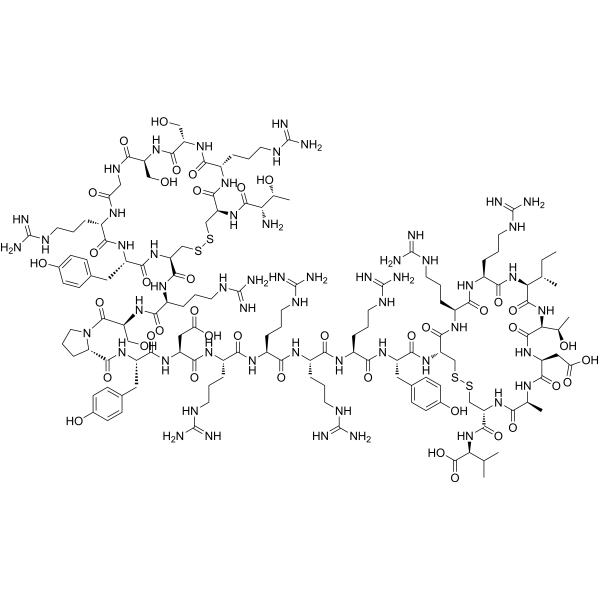
-
- HY-P5754B
-
|
|
Apoptosis
|
Neurological Disease
|
|
TAT-NEP1-40 acetate is a therapeutic candidate for axonal regeneration and functional recovery after stroke. TAT-NEP1-40 acetate can protect PC12 cells against oxygen and glucose deprivation (OGD) and promote neurite outgrowth. TAT-NEP1-40 acetate protects the brain against ischemia/reperfusion injury through inhibition of neuronal apoptosis. TAT-NEP1-40 acetate can be efficiently delivered into the rat brains .
|
-

-
- HY-P5754
-
|
|
Apoptosis
|
Neurological Disease
|
|
TAT-NEP1-40 is a BBB-penatrable peptide. TAT-NEP1-40 protects PC12 cells against oxygen and glucose deprivation (OGD), and promotes neurite outgrowth. TAT-NEP1-40 also improves ischemia-induced neurologic outcomes by inhibiting cell apoptosis in ischemic brains. TAT-NEP1-40 can be used for research of CNS injuries, such as axonal regeneration and functional recovery after stroke .
|
-

-
- HY-P5754A
-
|
|
Apoptosis
|
Neurological Disease
|
|
TAT-NEP1-40 TFA is a BBB-penatrable peptide. TAT-NEP1-40 TFA protects PC12 cells against oxygen and glucose deprivation (OGD), and promotes neurite outgrowth. TAT-NEP1-40 TFA also improves ischemia-induced neurologic outcomes by inhibiting cell apoptosis in ischemic brains. TAT-NEP1-40 TFA can be used for research of CNS injuries, such as axonal regeneration and functional recovery after stroke .
|
-

| Cat. No. |
Product Name |
Target |
Research Area |
-
- HY-P4250
-
|
|
Peptides
|
Others
|
|
Tetraarginine (RRRR), consisting of four arginines, is used in cell-penetrating peptide-based gene delivery vehicles .
|
-
- HY-P4250A
-
|
|
Peptides
|
Others
|
|
Arg-Arg-Arg-Arg (acetate), consisting of four arginines, is used in cell-penetrating peptide-based gene delivery vehicles .
|
-
- HY-P4316
-
|
|
Peptides
|
Others
|
|
Cys(NPys)-D{Arg-Arg-Arg-Arg-Arg-Arg-Arg-Arg-Arg}-NH2 is a cell-penetrating polypeptide composed of nine arginines and cysteines, used to carry therapeutic agent into the cell .
|
-
- HY-P3349
-
|
|
Bacterial
|
Infection
|
|
c[Arg-Arg-Arg-Arg-Nal-Nal-Nal] (Compound 9C) shows broad-spectrum activity against drug-resistant Gram-positive and Gram-negative bacteria, with MICs of 3.1, 3,1, 12.5, and 25 μg/mL for MRSA (ATCC BAA-1556), S. aureus (ATCC 29213), P. aeruginosa (ATCC 27883), and E. coli (ATCC 25922), respectively .
|
-
- HY-P3348
-
|
|
Bacterial
|
Infection
|
|
c[Arg-Arg-Arg-Arg-Dip-Dip-Dip] (Compound 8C) shows broad-spectrum activity against drug-resistant Gram-positive and Gram-negative bacteria, with MICs of 3.1, 3,1, 12.5, and 12.5 μg/mL for MRSA (ATCC BAA-1556), S. aureus (ATCC 29213), P. aeruginosa (ATCC 27883), and E. coli (ATCC 25922), respectively .
|
-
- HY-P10167
-
|
|
Phosphatase
|
Others
|
|
11R-CaN-AID is a potent and cell permeant inhibitor of calcineurin .
|
-
- HY-P10168
-
|
|
Peptides
|
Others
|
|
11R-CaN-CON is a control inactive peptide and can be used as a negative control for 11R-CaN-AID (HY-P10167) .
|
-
- HY-P0121
-
ReACp53
2 Publications Verification
|
MDM-2/p53
|
Cancer
|
|
ReACp53 could inhibit p53 amyloid formation and rescue p53 function in cancer cell lines.
|
-
- HY-P0133
-
|
Nona-L-Arginine; Peptide R9
|
Peptides
|
Neurological Disease
|
|
(Arg)9 (Nona-L-arginine) is a cell-penetrating peptide (CPP) made up of 9 arginine residues. (Arg)9 has neuroprotective property, exhibits neuroprotective activity with an IC50 of 0.78 μM in the glutamic acid model .
|
-
- HY-P0133A
-
|
Nona-L-Arginine TFA; Peptide R9 TFA
|
Peptides
|
Neurological Disease
|
|
(Arg)9 (Nona-L-arginine) TFA is a cell-penetrating peptide (CPP) made up of 9 arginine residues. (Arg)9 TFA has neuroprotective property, exhibits neuroprotective activity with an IC50 of 0.78 μM in the glutamic acid model .
|
-
- HY-P2500
-
|
|
Peptides
|
Others
|
|
(Arg)9, FAM-labeled, a cell-penetrating peptide (CPP), is a nona-arginine (ARG) with FAM label. CPPs have emerged as powerful tools for delivering bioactive cargoes into the cytosol of intact cells .
|
-
- HY-P4083
-
|
|
Peptides
|
Others
|
|
(Arg)9,TAMRA-labeled is a TAMRA-labeled cell permeable peptide. (Arg)9 is a cell-permeable peptide used for drug delivery .
|
-
- HY-P4078
-
|
|
Peptides
|
Others
|
|
(Arg)9 biotin labeled is a cell-permeable peptide. (Arg)9 biotin labeled can be used for drug delivery. (Arg)9 biotin labeled can traverse the plasma membrane of eukaryotic cells .
|
-
- HY-P4087
-
|
|
Peptides
|
Others
|
|
Cys(Npys)-(Arg)9 is a cell penetrating peptide. Cys(Npys)-(Arg)9 is comprised of 9 D-Arginine residues and an activated cysteine residue C(Npys). Cys(Npys)-(Arg)9 can be used as a carrier peptide applicable in conjugation and cell permable studies .
|
-
- HY-P3245
-
|
|
Apoptosis
|
Cancer
|
|
HXR9 is a cell-permeable peptide and a competitive antagonist of HOX/PBX interaction. HXR9 antagonizes the interaction between HOX and a second transcrip-tion factor (PBX), which binds to HOX proteins in paralogue groups1 to 8. HXR9 selectively decreases cell proliferation and promotes apoptosis in cells with a high level of expression of the HOXA/PBX3 genes, such as MLL-rearranged leukemic cells .
|
-
- HY-P10387
-
|
|
METTL3
Apoptosis
|
Cancer
|
|
RSM3, a stapled peptide, is a METTL3-METTL14 inhibitor with an Kd of 3.10 μM. RSM3 inhibits tumor growth while induces cell apoptosis. RSM3 can be used for study of cancer .
|
-
- HY-P2247
-
|
|
JNK
|
Cancer
|
|
JTP10-△-R9 TFA is a selective JNK2 peptide inhibitor, with an IC50 of 89 nM, exhibiting 10-fold selectivity for JNK2 over JNK1 and JNK3 .
|
-
- HY-P2483A
-
|
|
Peptides
|
Others
|
|
Octaarginine TFA is a cell-penetrating peptide (CPP). CPPs show membrane translocation activities. CPPs are used for intracellular delivery of various membrane-impermeable bioactive agents because of their intrinsic ability to gain access to cell interiors. CPPs have also been used to deliver antibacterial agents to target intracellular bacteria .
|
-
- HY-P2282
-
|
|
STAT
|
Cancer
|
|
APTSTAT3-9R, a specific STAT3-binding peptide, inhibits STAT3 activation and downstream signaling by specifically blocking STAT3 phosphorylation. APTSTAT3-9R exerts antiproliferative effects and antitumor activity .
|
-
- HY-P4086
-
|
|
RABV
|
Infection
|
|
Chimeric Rabies Virus Glycoprotein Fragment (RVG-9R), a chimeric peptide consisting of 29 amino acids, is synthesized by adding nona-arginine motif to the carboxy terminus of RVG (rabies virus glycoprotein). Chimeric Rabies Virus Glycoprotein Fragment (RVG-9R) is positively charged and able to bind negatively charged nucleic acids via charge interaction .
|
-
- HY-P10116
-
|
APTscr-9R
|
Peptides
|
Others
|
|
APTSTAT3-9R, scrambled (APTscr-9R) is a control peptide that forms a structure similar to that of APTSTAT3-9R but possesses a scrambled sequence in the target-binding region .
|
-
- HY-P10150
-
|
|
Bacterial
|
Infection
|
|
IN-2-LF is an inhibitor of lethal factor. IN-2-LF also inhibits furin with an IC50 of 2 μM. IN-2-LF enhances protection against anthrax lethal toxin when in combination with D6R .
|
-
- HY-P1925A
-
|
|
PI3K
Reactive Oxygen Species
Apoptosis
|
Cancer
|
|
GO-203 TFA is a potent MUC1-C oncoprotein inhibitor. GO-203 TFA is an all D-amino acid peptide that consists of a poly-R transduction domain linked to a CQCRRKN motif that binds to the MUC1-C cytoplasmic tail and blocks MUC1-C homodimerization. GO-203 TFA downregulates TIGAR (TP53-induced glycolysis and apoptosis regulator) protein synthesis by inhibiting the PI3K-AKT-S6K1 pathway. GO-203 TFA induces the production of ROS and loss of mitochondrial transmembrane potential. GO-203 TFA inhibits the growth of colon cancer cells in vitro and as xenografts in nude mice .
|
-
- HY-126810A
-
|
|
Fungal
|
Infection
|
|
NP213 TFA is a rapidly acting, novel, first-in-class synthetic antimicrobial peptide (AMP), has anti-fungal activities. NP213 TFA targets the fungal cytoplasmic membrane and plays it role via membrane perturbation and disruption. NP213 TFA is effective and well-tolerated in resolving nail fungal infections .
|
-
- HY-P5107
-
|
|
VEGFR
|
Cancer
|
|
Protein LMWP is a cell-penetrating peptide with vascular endothelial growth factor (VEGF) inhibitory activity. Protein LMWP can inhibit tumor growth and is used in cancer research .
|
-
- HY-P5552
-
|
|
Bacterial
Parasite
Fungal
|
Infection
|
|
Melimine is a hybrid antimicrobial peptide of Melittin (HY-P0233) and Protamine. Melimine is active against P. aeruginosa and S. aureus. Melimine has broad spectrum activity against bacteria, fungi and protozoa .
|
-
- HY-P4247
-
|
|
Peptides
|
Others
|
|
Hexa-arginine, consisting of six arginines, is a polycationic peptide that can penetrate cells efficiently and is mainly used for the intracellular delivery of low-molecular-weight agents, biomolecules, and particles .
|
-
- HY-P1028A
-
|
Furin Inhibitor II TFA
|
Bacterial
|
Infection
|
|
Hexa-D-arginine TFA (Furin Inhibitor II TFA) is a stable furin inhibitor with Ki values 106 nM, 580 nM and 13.2 μM for furin, PACE4 and prohormone convertase-1 (PC1), respectively. Hexa-D-arginine TFA blocks Pseudomonas exotoxin A and anthrax toxins toxicity in vitro and in vivo .
|
-
- HY-P10028
-
|
|
Peptides
|
Cancer
|
|
HCT116 is a peptidomimetic inhibitor of N-terminal methyltransferase 1/2 (NTMT1/2) with an IC50 of 54 nM. HCT116 can inhibit the N-terminal methylation level of NTMT1/2 substrates in HCT116 cells, and is used for the study of NTMT1/2 probes.
|
-
- HY-P4869
-
-
- HY-P5557
-
|
|
Bacterial
Necroptosis
|
Cancer
|
|
TP4 (Nile tilapia piscidin) is an orally active piscidin-like antimicrobial peptide. TP4 inhibits multiple gram positive and negative strains (MIC: 0.03-10 μg/mL). TP4 shows hemolytic activities. TP4 enhances immune response, antioxidant activity, and intestinal health against bacterial infections. TP4 also has anti-tumor effect, and induces necrosis by triggering mitochondrial dysfunction in cancer cells .
|
-
- HY-P1175
-
|
|
TRP Channel
|
Neurological Disease
|
|
L-R4W2 is a potent antagonist of vanilloid receptor 1 (VR1, TRPV1), with an IC50 of 0.1 μM. L-R4W2 may act as a potent analgesic .
|
-
- HY-P1175A
-
|
|
TRP Channel
|
Neurological Disease
|
|
L-R4W2 TFA is a potent antagonist of vanilloid receptor 1 (VR1, TRPV1), with an IC50 of 0.1 μM. L-R4W2 TFA may act as a potent analgesic .
|
-
- HY-P1586
-
|
HIV-1 rev Protein (34-50)
|
HIV
|
Infection
|
|
HIV-1 Rev (34-50) is a 17-aa peptide derived from the Rev-responsive element (RRE)-binding domains of Rev in HIV-1, with anti-HIV-1 activity.
|
-
- HY-P10445
-
|
|
Liposome
|
Cancer
|
|
TAT-PiET is a liposome to simulate biological phospholipid membrane. Liposomes are the main component of vesicles with concentric phospholipid bilayer membranes, which can be used to construct drug delivery systems for anti-cancer and anti-infection fields. Highly polar water-soluble payloads can be trapped in the internal aqueous space of liposomes, while lipophilic payloads can partition into and become part of the lipid bilayer. Especially for delivering antisense oligonucleotides, it can overcome problems such as inefficient cellular uptake and rapid loss in the body .
|
-
- HY-P10275
-
|
|
Peptides
|
Neurological Disease
|
|
Tat-NTS peptide is a cell-penetrating peptide with neuroprotective effects. Tat-NTS peptide can specifically inhibit the nuclear translocation of ANXA1 and reduce neuronal apoptosis in ischemic areas. Moreover, Tat-NTS peptide can reduce the volume of cerebral ischemic infarction and can be used in the research of ischemic stroke .
|
-
- HY-P10048
-
-
- HY-P10446
-
|
|
Liposome
|
Cancer
|
|
TAT-PiET-PROTAC is a liposome to simulate biological phospholipid membrane. Liposomes are the main component of vesicles with concentric phospholipid bilayer membranes, which can be used to construct drug delivery systems for anti-cancer and anti-infection fields. Highly polar water-soluble payloads can be trapped in the internal aqueous space of liposomes, while lipophilic payloads can partition into and become part of the lipid bilayer. Especially for delivering antisense oligonucleotides, it can overcome problems such as inefficient cellular uptake and rapid loss in the body .
|
-
- HY-P10360
-
|
|
α-synuclein
|
Neurological Disease
|
|
Tat-βsyn-degron is an α-synuclein knockdown peptide. Tat-βsyn-degron binds toα-synuclein and reduces α-synuclein levels in primary rat cortical neuron cultures. Tat-βsyn-degron also reduces α-synuclein levels and decreases the parkinsonian toxin-induced neuronal damage and motor impairment in a mouse toxicity model of PD .
|
-
- HY-P5848
-
|
|
nAChR
|
Neurological Disease
|
|
αO-Conotoxin GeXIVA is a potent α9α10 nAChR antagonist with an IC50 of 12 nM against rat α9α10. αO-Conotoxin GeXIVA shows analgesic in animal models of pain .
|
-
- HY-P5754B
-
|
|
Apoptosis
|
Neurological Disease
|
|
TAT-NEP1-40 acetate is a therapeutic candidate for axonal regeneration and functional recovery after stroke. TAT-NEP1-40 acetate can protect PC12 cells against oxygen and glucose deprivation (OGD) and promote neurite outgrowth. TAT-NEP1-40 acetate protects the brain against ischemia/reperfusion injury through inhibition of neuronal apoptosis. TAT-NEP1-40 acetate can be efficiently delivered into the rat brains .
|
-
- HY-P5754
-
|
|
Apoptosis
|
Neurological Disease
|
|
TAT-NEP1-40 is a BBB-penatrable peptide. TAT-NEP1-40 protects PC12 cells against oxygen and glucose deprivation (OGD), and promotes neurite outgrowth. TAT-NEP1-40 also improves ischemia-induced neurologic outcomes by inhibiting cell apoptosis in ischemic brains. TAT-NEP1-40 can be used for research of CNS injuries, such as axonal regeneration and functional recovery after stroke .
|
-
- HY-P5754A
-
|
|
Apoptosis
|
Neurological Disease
|
|
TAT-NEP1-40 TFA is a BBB-penatrable peptide. TAT-NEP1-40 TFA protects PC12 cells against oxygen and glucose deprivation (OGD), and promotes neurite outgrowth. TAT-NEP1-40 TFA also improves ischemia-induced neurologic outcomes by inhibiting cell apoptosis in ischemic brains. TAT-NEP1-40 TFA can be used for research of CNS injuries, such as axonal regeneration and functional recovery after stroke .
|
Your information is safe with us. * Required Fields.
Inquiry Information
- Product Name:
- Cat. No.:
- Quantity:
- MCE Japan Authorized Agent:







![c[<em>Arg-Arg-Arg-Arg</em>-Nal-Nal-Nal]](http://file.medchemexpress.com/product_pic/hy-p3349.gif)
![c[<em>Arg-Arg-Arg-Arg</em>-Dip-Dip-Dip]](http://file.medchemexpress.com/product_pic/hy-p3348.gif)

























